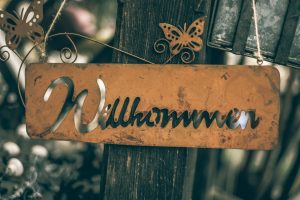😁German Level 4, Activity 01: Einleitung / Introduction (Face to Face)

Semantic Topics: Introduction, Einführung, Fragen, Questions, Conjunctions, Konjunktionen.
Products: Bingo Cards, Bingokarten.
Practices: Taking turns answering questions in German. Listening to classmates to get to know them better. Abwechselnd beantworten Fragen auf Deutsch. Mitschülern zuhören, um sie besser kennenzulernen.
Perspectives: Appreciating the differences in the students studying German. Die Unterschiede bei den Deutschlernenden erkennen.
- Standard 1.1 Students engage in conversations, provide and obtain information, express feelings and emotions, and exchange opinions.
- Standard 1.2 Students understand and interpret spoken and written language on a variety of topics.
- Standard 1.3 Students present information, concepts, and ideas to an audience of listeners or readers on a variety of topics.
Idaho State Content Standards:
- Objective: COMM 2.1 Understand, interpret, and analyze what is heard, read, or viewed on a variety of topics.
- Objective: CONN 1.1 Compare and contrast information acquired from other content areas.
NCSSFL-ACTFL Can-Do Statements:
- I can ask open ended questions about technology, family, food, and travel.
- I can communicate in spontaneous spoken, written, or signed conversations on both very familiar and everyday topics.
- I can create sentences and series of sentences to ask and answer a variety of questions.
Materials Needed:
- Google Presentation
- Bingo Cards
- Wet erase markers (1 for each student)
- Spray bottle and towel
Would you like to make changes to the materials? Access the template(s) below:
(Canva Template(s), free account required)
Warm-Up
1. Have each student introduce themselves and tell one fun fact about their summer.
- Lassen Sie jeden Schüler sich vorstellen und eine lustige Tatsache über seinen Sommer erzählen.
2. Review the Can-Do Statements with the Students.
- Gehen Sie die Kann-Aussagen mit den Schülern durch.
Main Activity
Before starting the activity, model a few sample questions for the students.
Bevor Sie mit der Aktivität beginnen, modellieren Sie ein paar Beispielfragen für die Schüler.
Examples:
Beispiele:
- Technologie Fragen: Bevorzugen Sie Android oder Apple und warum? (Technology question: Do you prefer Android or Apple, and why?)
- Antwort: Ich habe ein Apple iPhone und es gefällt mir, weil es einfach zu bedienen ist, aber viel Geld kostet. (Answer: I have an Apple iPhone and I like it because it is easy to use, but it costs a lot of money.)
- Familienfrage: Mit welchem Familienmitglied verstehst du dich am besten und warum? (Family Question: Which family member do you get along with the best? Why?)
- Antwort: Ich verstehe mich am besten mit meiner Vater weil wir immer das gleiche Aktivitäten genießen. (Answer: I get along with my father the best because we always enjoy the same activities.
1. Students must formulate OPEN-ENDED questions relating to the picture in the square and ask another student.
Die Schüler müssen offene Fragen zu dem Bild auf dem Quadrat formulieren und einen anderen Schüler fragen.
2. Once the student answers, they sign that square. Then the other person can ask a question.
Sobald der Schüler antwortet, unterschreibt er dieses Quadrat. Dann kann die andere Person eine Frage stellen.
3. Students should try to get a BLACKOUT (getting a signature on each square) or BINGO (by asking students questions about pictures in a row).
Die Schüler sollten versuchen, einen BLACKOUT (eine Unterschrift auf jedem Feld) oder BINGO (indem sie den Schülern hintereinander Fragen zu Bildern stellen) zu erhalten.
Wrap-Up
After everyone is done, go square by square and ask students to report back what they learned from the other students (their answers) about the squares from the questions they asked.
Nachdem alle fertig sind, gehen Sie Quadrat für Quadrat durch und bitten Sie die Schüler, zu berichten, was sie von den anderen Schülern (ihre Antworten) gelernt haben.
End of activity:
- Read Can-Do statements once more and have students evaluate their confidence. (Use thumbs up/thumbs down)
- Encourage students to be honest in their self-evaluation.
- Pay attention, and try to use feedback for future labs!
NCSSFL-ACTFL Can-Do Statements:
- I can ask open ended questions about technology, family, food, and travel.
- I can communicate in spontaneous spoken, written, or signed conversations on both very familiar and everyday topics.
- I can create sentences and series of sentences to ask and answer a variety of questions.
Cultural Resources
Linked here is an article discussing the importance of creating some stress free environments during language learning. As a helpful reminder for students, this article will be linked in the Cultural Resources section in the first activity of each section.. https://languagelearnersjournal.com/2018/05/14/is-stress-impacting-your-language-learning-ability/
How to Remix a Pathways Project Activity
Feeling creative? The Pathways Project needs your help in remixing activities for the K-12 classroom.
Try taking an activity to the next level by:
- Add new content (something you’ve created or another OER source)
- Contribute additional activity suggestions
- Integrate authentic materials such as videos, infographics, photos, etc.
- Suggest how to implement the activity in the classroom
- Customize the content for a specific audience or group of learners (for example, K-5 learners or to differentiate for student’s needs)
We want to make it easy to share back with the larger Pathways Project Community! Simply, click this link to remix this activity.
Please consider sharing your remixed activity with us by emailing the activity link to Pathwaysproject@boisestate.edu so that Pathways continues to grow!

